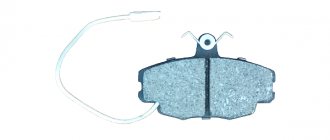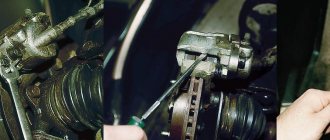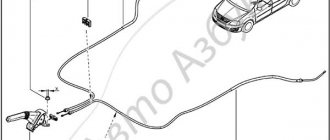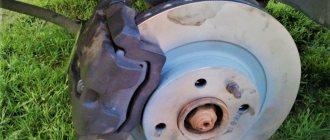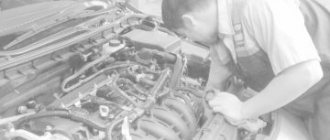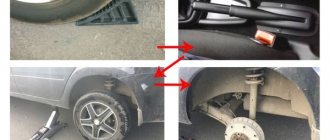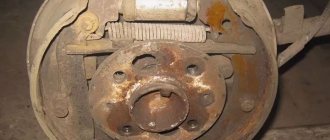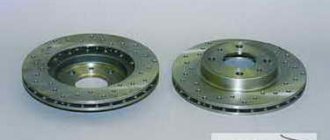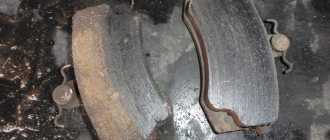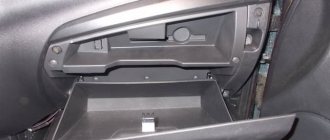The brake system in any car requires timely inspection for wear of its components, which implies the need for further replacement of all failed parts. These actions cannot be neglected, since the safety of the driver and his companions directly depends on the effectiveness of the entire braking unit. Such statements are also typical for the domestic Lada Lagrus station wagon, which today will be the “hero” of our material.
Signs of pad wear
The instruction manual for a Lada Lagrus with a 16-valve engine, as a rule, contains very detailed information regarding this issue. It also displays all the parameters that characterize the front brake pads. The degree of wear of these consumable components is determined by the residual thickness of the friction linings, which come into direct contact with the discs or drums during braking.
In this regard, gradual and natural abrasion occurs. Many experts are inclined to believe that front brake pads are the most intensively worn consumables. Here you should not wait until the end of the scheduled service life, expressed in mileage (20-30 thousand km), but observe the level of wear with sufficient frequency, and then make a decision on replacement. It is no secret that failed front brake pads provoke increased wear on the working surfaces of discs or drums. Replacing the front brake pads in a Lada Lagrus car is very expensive, so it is not recommended to “bring” the car to this condition.
Renault Sandero Stepway trunk volume
Renault Sandero tank volume
Spoiler for Renault Sandero
Some of the most common signs of wear include the following:
- the appearance of a squeak when the brake is activated;
- spontaneous change in direction of movement from a straight trajectory;
- the brake pedal vibrates when pressed;
- it is impossible to lock the wheels with the handbrake, even with the drive cable fully tensioned;
- reducing the thickness of the disc beyond the limit of 21.8 mm;
- the thickness of the friction linings on the pads has approached the critical value of 2 mm;
- the working surface of the pads is dotted with grooves and chips.
Regular inspection followed by replacement of worn-out components allows you to eliminate the manifestation of these factors.
Front brake pads Lada Largus prices
Stop! Don't go anywhere! You haven’t read the article to the end yet and have completely forgotten about prices. Let's look at the prices for popular front brake pads for Lada Largus.
Table 1 - prices for front brake pads Lada Largus 8 valves
| Brand | Name | vendor code | Price, rub |
| LADA Standard | Brake pads Lada largus renault logan (04-), sandero (08-) front (4 pcs.) “LADA STANDART” | LS0K7-3501800-81 | 800 |
| Renault | Front disc brake pads, set | 41 06 021 92R | 1600 |
| Lada | Front disc brake pads set | 410602192R | 1800 |
| Gallant | Front brake pad largus, logan, 8kl, with plates | GL.BP.1.5 | 500 |
| NiBK | Front disc brake pads, set | PN0284W | 1200 |
| Miles | Brake pads (new mixture) renault logan 04-/sandero 08-/clio 91- front with sensor e400048 | E400048 | 650 |
| Stellox | Front disc brake pads, set | 152 032-SX | 650 |
| Kraft | Disc brake pads | KT 091371 | 650 |
| SCT | Disc brake pads, set | SP 189 | 750 |
| Hi-Q | Front disc brake pads, set | SP1243 | 780 |
| LYNXauto | Front disc brake pads, set | BD-6301 | 1050 |
Table 2 - prices for front brake pads Lada Largus 16 valves
Procedure
- First, we purchase suitable pads. The set of front consumables consists of 4 pieces (2 pieces on each side).
- We control the brake circuit fluid level in the corresponding reservoir (under the hood) using the marks on its body. If the level reaches the maximum level, then it will need to be taken with a syringe, since after installing the new pads there will be a natural (due to the greater thickness of the pads) rise.
- We loosen the tightening torques of the bolts of the front wheel from which the replacement is supposed to begin.
- We hang this part of the car with any available device designed for this purpose. We remove the wheel. Don't forget about safety supports (if a jack is used).
- We take a screwdriver, which we insert between the pad and the disc, and with a pressing force we move it towards the cylinder. The rod is hidden in the cylinder, which provides free space for removing the pads.
- Now we loosen the tightening torque of the caliper bracket, and then move it up.
- We remove the old pads.
- We inspect the springs of the clamping mechanism for their deformation and breakage. If this fact is obvious, then we change it.
- We check the integrity of the rubber covers on the caliper guides. We lubricate the guides themselves with a special compound. This will prevent them from souring, and the bracket will move freely during the exit or entry of the piston.
- We carefully clean the seats for new pads.
- The linings on “fresh” pads are thicker than on old products, so the piston must be recessed to the full extent of its stroke. This will provide enough space for the correct installation of consumables.
- After installation, perform the assembly process in reverse order.
Replacement of front brake pads is completed.
We repeat the entire list of these manipulations on the other side of the LADA Largus.
If there is a need to replace the rear pads, then the principle of operation is similar, with the exception of some nuances.
Causes of malfunction
The causes of rear brake pad failure are no different from the front ones. But it’s worth dwelling on them to know them:
- Wear of the friction part. It can only be seen if you take the drum apart. According to the manufacturer's recommendations, the friction part should not be less than 2 mm.
- If brake fluid gets on the linings, it also leads to replacing the pads.
- The friction part is cracked, chipped or chipped. This indicates that the pad needs to be replaced.
Tuning
Many car enthusiasts want to improve the rear brake; to do this, they replace the standard drums with ventilated disc brakes. This operation is done quite simply, but in frequent cases, the hub needs to be replaced.
Installing rear disc brakes
The old rear drums are thrown out and replaced with brake discs, calipers and front pads. This significantly improves the car's braking. These and Sparko offer a full set of rear ventilated brake discs.
As practice shows, disc brakes are 30% more efficient in use, and replacement is carried out in the same way as front brakes. In this case, you do not need to buy separate pads for the rear and front parts. It is enough to buy 4 sets of front pads (each set contains 2 pads).
How to operate the car after replacing the pads?
After installing new pads in a Lada Lagrus with a 16-valve engine, you should not rush to drive onto roads with heavy traffic. The first presses on the brake pedal can cause inefficiency of the entire system, because consumables require time to grind into the working surfaces of the discs. Contact during this period does not occur over the entire surface, which explains the low performance of the pads. Over time, the situation will normalize. To properly “break in” the LADA Largus pads, we recommend choosing road sections with no heavy traffic. Once the process of grinding the pads to the discs is complete, you can observe the effectiveness of the brakes. At first, we recommend avoiding sudden braking to prevent excessive heating of the new linings. In “quiet” mode you should travel at least 100 km.
Let's sum it up
Since the LADA Largus brake system has a significant impact on the safety of movement, the elements require increased attention and timely replacement of the front brake pads. We do not recommend allowing excessive levels of wear on the working surfaces. The specified consumable components that have become unusable should be promptly replaced. Buy products only of decent quality, which will allow you to gain confidence in the stable functioning of the brake unit only in normal mode, but also in emergency situations.
The principle of operation of Largus brakes
Lada Largus is equipped with a modern European brake mechanism, which was developed through various tests and trials. The heir to Renault Logan adopted the quality and reliability of the brakes from its predecessor. The following service brakes are installed on the station wagon.
| Location and type | Characteristics |
| The front ones are disc. | The front ones are ventilated and have a floating bracket. |
| The rear ones are drums. | The rear brake system is a closed drum in which the centering of the pads is carried out independently using mechanisms that regulate the gap between the pads. |
The brake mechanisms are hydraulically actuated, are dual-circuit, arranged diagonally and have a vacuum booster. A huge plus in some trim levels is the presence of an anti-lock braking system (ABS), which has become an indispensable thing in modern cars. It prevents the wheels from locking during braking, in particular emergency braking. The handbrake is actuated mechanically by transmitting drive to the rear axle using a lever.
There are misunderstandings on various forums about whether the same pads are installed on Largus, which has an engine with 16 valves and which has 8 valves. On configurations with separate power units, different brake systems are installed with different calipers and brake disc dimensions. Therefore, its configuration depends on whether your car has 8 valves on the engine or 16 valves. Based on this, one or another mechanism is established.
The Lada's pads with a 16-valve unit are slightly better.
You will need: wrenches “13”, “15”, a wrench for wheel bolts, sliding pliers, grease.
1. Loosen the tightening of the left front wheel mounting bolts; rear wheels have anti-recoil stops (“shoe”). Using a jack, lift the front of the car, place it on reliable supports, and remove the left front wheel. 2. Using a large screwdriver, push the piston all the way into the bottom of the slave cylinder to move the brake pads away from the disc.
3. Loosen the bolt securing the lower caliper guide pin, holding the pin from turning with a second wrench.
4. To do this, remove the guide pin
5. Lift the caliper up.
6. . and remove the outer one.
7. . and internal brake pads.
This is what the front brake pads look like. All front brake pads are identical.
. and have the same catalog numbers.
8. Remove the top...
9. . and lower pad pressure springs and inspect them.
Replace deformed or heavily corroded springs.
Whenever you replace brake pads, be sure to check the condition of the protective rubber covers of the guide pin and the movement of the caliper relative to the brake pad guide. If movement is difficult, lubricate the caliper guide pins with grease. Similarly, lubricate the second guide pin and its cover. Install the guide pins in the reverse order of removal. Replace the rubber guide pin boots if they are hardened, deformed or torn. 10. Install the brake pads on the Lada Largus in the reverse order of removal. Apply anaerobic thread locker to the threaded portion of the guide pin mounting bolts.
11. Replace the brake pads of the right front wheel in the same way. 12. Check and, if necessary, restore the brake fluid level in the master cylinder reservoir.
